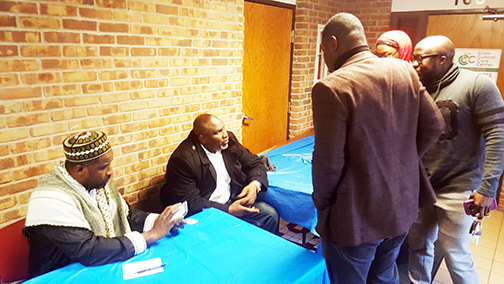

Not everyone can work from home or cease traveling. Here’s what you can do when circumstance forces you to be out and about during the COVID-19 outbreak.
By MIT’s Technology Review’s Tanya Basu & Karen Hao
In theory, never leaving home during the coronavirus pandemic is the most effective means of prevention. It reduces your chance of infection and quickly contains the disease’s spread. A recent study in Science found, for example, that this kind of distancing is even better than widespread travel bans or restrictions.
In practice, however, it’s not always possible to hole up. Your circumstances may not afford you the luxury of working from home or avoiding public transit. And sometimes life happens and you just need to get on a plane.
The good news is that tamping down the coronavirus isn’t an all-or-nothing game. There are still many ways you can practice responsible social distancing even when you have to be out and about in the world. In addition to the basics—don’t touch your face, and wash your hands often with soap and water for 20 seconds—here are some other tips, collected from half a dozen experts, to follow in different areas of your life.
The bottom line: don’t stress too much. It’s equally important to “keep some sense of sanity,” says Moses Turkle Bility, an assistant professor of infectious diseases and microbiology at the University of Pittsburgh: “Your mental health and well-being affect your immune system.” Do what you can and develop habits you can stick to, but don’t panic if you can’t do everything.
Here’s what you should do when you…
- take public transit
- take flights or long-haul bus and train rides
- are sick
- need food
- work out
- leave and come back home
- have kids
What to do when you take public transit
Stagger commute times. If you can’t drive or walk where you need to go, consider commuting by public transit during off-peak hours. Spreading out commute times, even by a small amount, can help reduce transmission risk from overcrowded subways and buses, says Julie McMurry, an assistant professor in the College of Public Health at Oregon State University, who created the popular Flatten the Curve web page with tips to contain Covid-19.
Avoid surfaces. While in transit, avoid touching poles and handles. Some recent research in a pre-print paper suggests that the virus can survive on hard surfaces for up to three days, although there is still no evidence that it is transmitted in this way. You can also wear gloves or create other makeshift barriers to stay protected, but they should be removed as soon as you are back indoors.
Monitor the coronavirus stats of your community and destination. With help from the CDC website, educate yourself about places to avoid—up until the minute you board. Information is changing “so quickly, in the matter of hours,” says Lin-Hwei Chen, president of the International Society of Travel Medicine and an associate professor at Harvard Medical School. It’s also important to check your hometown’s statistics so you know if you could have been exposed to the virus. Reconsider your travel if the risk is high.
Stay six feet away from people (as much as possible). The CDC’s six-feet rule might not be possible if you’re waiting in line to get to your seat, but there’s no need to rush to your boarding-area queue or crowd around a coffee shop.
Wear a makeshift mask (if it gives you peace of mind). It’s still unclear how much a mask will reduce a healthy person’s risk of contracting coronavirus, says Chen, but the extra protection doesn’t hurt. The caveat is if you’re not used to masks, you might fidget with it and thereby break a cardinal rule of coronavirus prevention: don’t touch your face.
Take a shower after you arrive. When you get to your destination, take a warm soap-and-water shower before interacting with people or lounging around too long in common spaces. “Soap and water is one of the best disinfectants,” says Bility. A bath is more comprehensive than hand-washing when you’ve been in contact with a lot of different surfaces. Avoid rewearing your travel clothes again until you’ve washed them.
What to do when you are sick
Stay at home. If you are sick (with something other than the coronavirus), reconsider whether you need to be out and about. The coronavirus is most threatening and more likely to result in complications when contracted along with another disease, says Fenyong Liu, a professor of virology at the University of California, Berkeley. With a weaker immune system, you will be more vulnerable. Exposing others to whatever you have, especially if they are immunocompromised, will make them more susceptible as well.
Wear a makeshift mask. But for essential trips, such as to go to the doctor, wear a mask or other makeshift barrier across your nose and mouth to protect others. Even a scarf or other cloth is better than nothing for reducing the spray of droplets when you cough or sneeze. Of course, the tighter the barrier the better, says McMurry. Do not, however, hoard surgical masks, which need to be reserved for front-line health-care responders. “That backfires for everyone,” McMurry says.
Call an ambulance. If you suspect you have coronavirus, call for an ambulance instead, says Liu. Traveling on public transit puts fellow passengers at too much risk. You could also contract another infection.
Get it delivered. Always opt for grocery or restaurant delivery if you have access to those services. It will reduce the flow of people circulating in-store and the chance of community spread. When the food arrives, wait for the delivery person to leave before you pick the package up. (Many delivery apps give you the option of specifying such instructions.) This minimizes delivery workers’—and the community’s—exposure to potential germs as they go from one home to another.
Use self-service checkout. If you have to go to the store, minimize contact with other people.
Decontaminate your packages. Once you’ve received your delivery or bought your food in-store, figure out a decontamination procedure. This might be overkill right now, says McMurry, “but it’s really important that everyone consider this a dry run.” Build the habit for when things get worse.
That means if you have a porch or other outside area where you can safely leave your packages, keep them there to air out for several hours. Again, experts don’t know how long the virus survives on surfaces, so the longer the wait you can afford, the better. Wear gloves or create a makeshift barrier when opening your package, and discard the outer layer. Or simply wash your hands diligently after you’re done handling it.
Wash and disinfect items before storage. After unwrapping the packages, use warm water and soap to scrub any washable items. While no specific studies have shown the effect of water and soap on the novel coronavirus, the combination is known to work against envelope viruses in general, says Bility. The soap damages the envelope and renders the virus ineffective. For other items that can’t be washed, use friction to wipe them down with soap and water or alcohol. The evaporative action of the alcohol inactivates the virus. (The EPA has also published a list of disinfectants that work.)
Opt for cooked over raw foods. Cooking produce is the safest way to guarantee decontamination, says Liu. But diligent washing with can also be a good defense.
Opt for in-home or outside exercises. Forgoing regular exercise can be challenging for mental health, especially during high-stress times such as this one. So consider developing routines that avoid the gym. Gyms are breeding grounds for many types of germs, which could weaken your immune system, but the heavy breathing and confined spaces also heighten the risk of coronavirus spread. Jog outside; do yoga in your bedroom; find in-home, equipment-free alternatives.
Avoid peak hours. If you do need to go to the gym, try to shift your workout schedule. Just as you should avoid peak hours on the subway, staggering workout times can help reduce risk of transmission.
Avoid high-contact equipment. Also avoid gym equipment that requires long periods of handling, like weights, and opt for things that don’t, like treadmills. Disinfect the equipment before and after use, and don’t wipe the sweat from your face with your hands during your workout.
Shower immediately after. A generally good rule regardless, but particularly important for disinfecting your body. You want to minimize the time you spend with potential contaminants on your clothes and skin.
Run errands together and during off-peak hours. Try to get as much done as possible in one fell swoop. “You want to minimize the number of trips, then stay home for as long a period of time as you can,” McMurry says. Also, try to avoid crowds by going to stores and public places early before work or late at night. In general, reduce the amount of time you spend in locations where you don’t know the level of infection, says Bility.
Don’t mix “outside” and “inside” clothes. Every time you get home, change your clothes—and shoes—and wash them as soon as possible. If you have the option, you can also leave coats and other hard-to-wash items outside to disinfect in the sunlight. “This is especially true for people that are in areas of high risk,” McMurry says.
Create a dedicated reentry zone. That staging area for packages is good for humans too: in addition to changing clothes and taking off shoes, use this space to disinfect your phone and keys. Phones, in particular, can be hard to disinfect, so consider putting yours in a thin plastic bag when you leave home. Wipe it down with soap and water or alcohol once you take it back out.
Take a shower after every outing. Of course, jump in the shower right away if you can. Children especially have a tendency to touch their faces, so bathe them with soap and water. If you don’t have time, at a bare minimum wash your and their face and hands, says Lauren Combe, a registered nurse and president of the National Association of School Nurses.
Don’t exaggerate or panic. Explain coronavirus in an age-appropriate manner, says Mark Reinecke, a clinical psychologist and director of the Child-Mind Institute. But “maintaining a sense of perspective becomes critically important.” Don’t freak out if your kid coughs or dwell for hours on coronavirus coverage. Your kids want to feel secure.
Demonstrate good habits. Teach kids how to cough and sneeze into the crook of their arm and thoroughly wash their face and hands while singing “Happy Birthday” twice, says Combe. If you’re tired of the same song, pick something else easy for kids to remember, like “Twinkle, Twinkle Little Star” and the ABCs.
Get creative with playdates. If their schools have closed, kids are prone to quickly develop cabin fever and feelings of isolation. Use technology creatively: give them permission to FaceTime or play video games with friends, Reinecke says. Online social activities can help maintain and foster friendships. You can also opt for no-tech solutions like board games and crafts with the family. If you do end up hosting a playdate, keep the group small, make sure the other kids are not sick, and don’t share utensils, says Combe.











